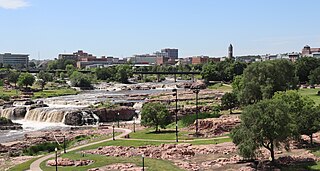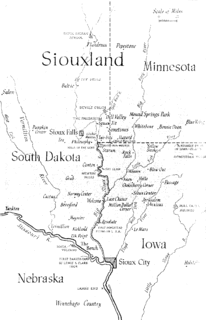
South Dakota is a U.S. state in the Midwestern region of the United States. It is named after the Lakota and Dakota Sioux Native American tribes, who comprise a large portion of the population and historically dominated the territory. South Dakota is the seventeenth largest by area, but the 5th least populous, and the 5th least densely populated of the 50 United States. As the southern part of the former Dakota Territory, South Dakota became a state on November 2, 1889, simultaneously with North Dakota. It is either the 39th or 40th state admitted to the union. President Benjamin Harrison shuffled the statehood papers before signing them so that no one could tell which became a state first. Pierre is the state capital and Sioux Falls, with a population of about 187,200, is South Dakota's largest city.

Interstate 29 (I-29) is an Interstate Highway in the Midwestern United States. I-29 runs from Kansas City, Missouri, at a junction with Interstate 35 and Interstate 70, to the Canada–US border near Pembina, North Dakota, where it connects with Manitoba Highway 75. The road follows the course of three major rivers, all of which form the borders of U.S. states. The southern portion of I-29 closely parallels the Missouri River from Kansas City northward to Sioux City, Iowa, where it crosses and then parallels the Big Sioux River. For the northern third of the highway, it closely follows the Red River of the North. The major cities that I-29 connects to includes Council Bluffs, Iowa; Sioux Falls, South Dakota; and Fargo, North Dakota.

Yankton is a city in and the county seat of Yankton County, South Dakota, United States.

Sioux Falls is the most populous city in the U.S. state of South Dakota and the 139th-most populous city in the United States. It is the county seat of Minnehaha County and also extends into Lincoln County to the south, proximate with the Iowa state line. As of 2019, Sioux Falls had an estimated population of 183,793. The Sioux Falls metro area accounts for more than a quarter of the state's entire population. Chartered in 1856 on the banks of the Big Sioux River, the city is situated in the rolling hills at the junction of interstates 29 and 90.

Siouxland is a vernacular region that encompasses the entire Big Sioux River drainage basin in the U.S. states of South Dakota, Minnesota, Nebraska and Iowa. The demonym for a resident of Siouxland is Siouxlander.

Frank Morris Byrne was the eighth Governor of South Dakota.
The University of Sioux Falls (USF) is a private Christian university in Sioux Falls, South Dakota. The university was founded in 1883. In fall 2014, the university enrolled a total of 1,142 undergraduate students and 311 graduate students.

The Dakota War of 1862, also known as the Sioux Uprising, the Dakota Uprising, the Sioux Outbreak of 1862, the Dakota Conflict, the U.S.–Dakota War of 1862 or Little Crow's War, was an armed conflict between the United States and several bands of Dakota. It began on August 17, 1862, along the Minnesota River in southwest Minnesota, four years after its admission as a state. Throughout the late 1850s in the lead-up to the war, treaty violations by the United States and late annuity payments by Indian agents caused increasing hunger and hardship among the Dakota. During the war, the Dakota made extensive attacks on hundreds of settlers and immigrants, which resulted in settler deaths, and caused many to flee the area. This ended with soldiers capturing hundreds of Dakota men and interning their families. A military tribunal quickly tried the men, sentencing 303 to death for their crimes. President Abraham Lincoln would later commute the sentence of 264 of them. The mass hanging of 38 Dakota men was conducted on December 26, 1862, in Mankato, Minnesota; it was the largest mass execution in United States history.

O'Gorman High School is a Catholic high school in Sioux Falls, South Dakota. The school was founded in 1961 and named after Thomas O'Gorman. O'Gorman is located in the Diocese of Sioux Falls.

The South Dakota Republican Party is the affiliate of the Republican Party in South Dakota. It currently holds all of the executive offices, the entire federal delegation, and supermajorities in both houses of the state legislature.

Martin E. Conlan was a Democratic state legislator in South Dakota. He lived in Alexandria, South Dakota, Hanson County, South Dakota for most of his life, but he was born in Raymond, Wisconsin, of Irish ancestry. He was educated in the public schools, and made his way to Dakota Territory in 1880 where he went into the flour and feed business. Martin was also a real estate dealer and the owner of a gravel pit and several farms. He served as postmaster, a member of the Alexandria city council and board of education. In 1888, Conlan was elected to serve in the first South Dakota State Senate for the term from 1889 to 1890 and was elected to serve again from 1893 to 1894. He and his wife Johanna had seven children, only the following names were known: Mary, Fred, Nellie, Eileen and Bessie. Conlan died in Sioux Falls, South Dakota on September 20, 1923.

Sioux Falls Christian Schools (SFC) is a private school located in Sioux Falls, South Dakota. The school was founded in 1958 as an elementary school named Calvin Christian. Since its inception, SFC has expanded and currently offers programs from pre-kindergarten to 12th grade and is accredited by the state of South Dakota and Christian Schools International.
The South Dakota Public Utilities Commission (PUC) regulates the energy, Telecommunications and grain warehouse companies located in South Dakota. The PUC keeps track of the Do Not Call Registry. Commissioners are elected to six-year terms in staggered elections, with special elections should vacancies arise.

A general election was held in the U.S. state of South Dakota on November 4, 2014. All of South Dakota's executive officers were up for election as well as a United States Senate seat and South Dakota's at-large seat in the United States House of Representatives. Primary elections were held on June 3, 2014.

Dustin M. Johnson is an American politician serving as the U.S. Representative for South Dakota's at-large congressional district since 2019. A member of the Republican Party, he previously served as a South Dakota Public Utilities Commissioner from 2005 to 2011, when he was appointed chief of staff to Governor Dennis Daugaard, a position he retained until 2014. Between his state political career and congressional service, Johnson was the vice president of Vantage Point Solutions in Mitchell, South Dakota.

The flag of Sioux Falls, South Dakota, consists of a zigzag pattern of thin white and blue lines, which divides an upper blue portion and a lower pinkish-red portion, and a yellow sun in the upper left corner. The zigzag represents the namesake falls of the Big Sioux River. The blue color and the sun allude to the flag of South Dakota. The pinkish-red portion represents the Sioux Quartzite nearby. The upward direction of the design represents the growth of Sioux Falls. The red, white and blue colors included in the flag are also a reference to the flag of the United States while maintaining city and state pride.

The COVID-19 pandemic in South Dakota is an ongoing viral pandemic of coronavirus disease 2019 (COVID-19), a novel infectious disease caused by severe acute respiratory syndrome coronavirus 2 (SARS-CoV-2). The state of South Dakota reported its first cases on March 10, 2020. On January 10, 2021, South Dakota public health authorities reported 241 new COVID-19 cases, 176 new probable cases, and 15 new deaths, increasing the state's cumulative totals to 92,967 confirmed cases, 10,351 probable cases, and 1,585 deaths.

South Dakota state elections in 2020 were held on Tuesday, November 3, 2020. Its primary elections were held on June 2, 2020.















